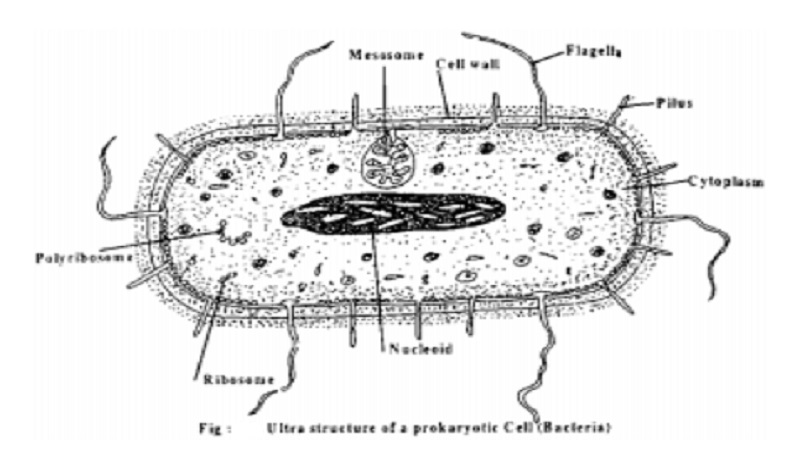Chapter: 11th 12th standard bio Biotany Plant Tree higher secondary school
prokaryotic cell And Ultra structure of a prokaryotic cell

Prokaryotes
In general, Prokaryotes consist of a single closed compartment containing the cytosol and bounded by the plasma membrane. Although bacterial cells do not have a well defined nucleus, the genetic material, DNA, is condensed into the central region of the cell. In all prokaryotic cells, most of or all the genetic information resides in a single circlular DNA molecule, in the central region of the cell. This region is often referred ot as incipient nucleus or nucleoid. In addition, most ribosomes, the cell's protein synthesizing centres are found in the DNA-free region of the cell. Some bacteria also have an invagination of the cell membrane called a mesosome, which is associated with synthesis of DNA and secretion of proteins. Thus we can not say that bacterial cells are completely devoid of internal organization.
Bacterial cells possess a cell wall which lies adjacent to the external side of the plasma membrane. The cell wall is composed of layers of peptidoglycan, a complex of proteins and oligosaccharides. It protects the cell and maintains its shape.
Some bacteria (eg E.coli) have a thin cell wall and an unusual outermembrane separated from the cell wall by the periplasmic space. Such bacteria are not stained by Gram staining technique and thus are classified as Gram-negative bacteria. Other bacteria (eg.Bacillus polymyxa) that have a thicker cell wall without an outer membrane take the Gram stain and thus are classified as Gram positive bacteria.
Ultra structure of a prokaryotic cell
The bacterium is surrounded by two definite membranes separated by the periplasmic space. The outer layer is rigid, serves for mechanical protection and is designated as the cell wall. The chemical composition of the cell wall is rather complex; it contains peptidoglycan, polysaccharides, lipid and protein molecules. One of the most abundant polypetides, porin, forms channels that allow for the diffusion of solutes. The plasma membrane is a lipoprotein structure serving as a molecular barrier with the surrounding medium. the plasma membrane controls the entry and exit of small molecules and ions. The enzymes involved in the oxidation of matabolites (i.e. the respiratory chain) as well as the photosystems used in photosynthesis, are present in the plasma membrane of prokaryotes.
The bacterial chromosome is a single circular molecule of naked DNA tightly coiled within the nucleoid which appears in the electron microscope as a lighter region of the protoplasm. It is amazing to note that the DNA of E.coli which measures about 1 mm long when uncoiled,contains all the genetic information of the organism. In this case, there is sufficient information to code for 2000 to 3000 different protiens.
The single chromosome or the DNA molecule is circular and at one point it is attached to the plasma membrane and it is believed that this attachment may help in the separation of two chromosomes after DNA replication.
In addition to a chromosome, certain bacteria contain a small, extrachromosomal circular DNA called plasmid. The plasmid is responsible for the antibiotic resistance in some bacteria. These plasmids are very much used in genetic engineering where the plasmids are separated and reincorporated, genes (specific pieces of DNA) can be inserted into plasmids, which are then transplanted into bacteria using the techniques of genetic engineering.
Surrounding the DNA in the darker region of the protoplasm are 20,000 to 30,000 particles called ribosomes. These are composed of RNA and proteins and are the sites of protein synthesis. Ribosomes exist in groups called polyribosomes or polysomes. Each ribosome consists of a large and a small sub unit. the remainder of the cell is filled with H2O, various RNAs, protein molecules (including enzymes) and various smaller molecules.
Certain motile bacteria have numerous, thin hair like processes of variable length called flagella. Flagella are used for locomotion. In contrast with the flagella of eukaryotic cells which contain 9+2 micortubles each flagellum in bacteria is made of a single fibril.
It was Fox et al who divided the living organisms into two kingdoms Prokaryota and Eukaryota. Prokaryotes are in turn classified into two major sub groups 1) the Archae bacteria and 2) Eubacteria. Cyanobacteria are included in the group Eubacteria. the Cyanobacterial prokaryotes, commonly called bluegreen algae, are photosynthetic. In cyanobacterial cells, the photosynthetic, respiratory and genetic apparatuses are present but not delimited from each other by any bounding membrane of their own. No sharp boundaries divide the cell into special regions. But, there are several cell components with characteristic fine structure. These are distributed throughout the cell in patterns varying from species to species and also in different developmental stages in the same species.
These cyanobacterial cells have an elaborate photosynthetic membrane system, composed of simple thylakoids and a central nucleoplasmic area which is usually fibrillar or granular or both. The cell also includes various kinds of granular inclusions, a rigid, several layered cell wall and a fibrous sheath over the cell wall.The characteristic collective properties of Cyanobacteria include oxygenic photosynthesis, chromatic adaptation, nitrogen fixation and a capacity for cellular differentiation by the formation of heterocysts, akinetes and hormogonia.
Related Topics